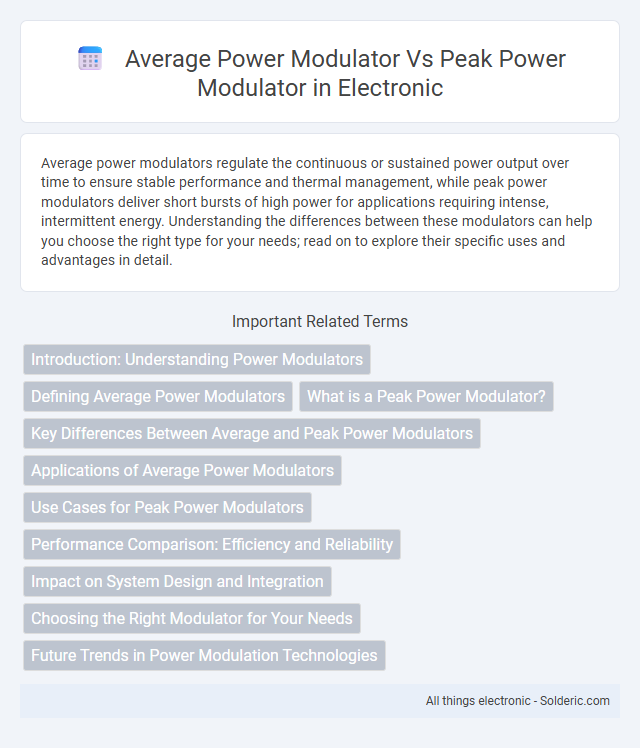Average power modulators regulate the continuous or sustained power output over time to ensure stable performance and thermal management, while peak power modulators deliver short bursts of high power for applications requiring intense, intermittent energy. Understanding the differences between these modulators can help you choose the right type for your needs; read on to explore their specific uses and advantages in detail.
Comparison Table
| Feature | Average Power Modulator | Peak Power Modulator |
|---|---|---|
| Power Output | Delivers continuous average power over time | Delivers short bursts of high peak power |
| Use Case | Ideal for steady-state applications | Suited for pulsed or high-power transient applications |
| Efficiency | Optimized for energy efficiency over long durations | Optimized for maximum power in short intervals |
| Thermal Management | Requires continuous cooling system | Cooling designed for intermittent high heat |
| Complexity | Typically simpler design | More complex due to handling peak loads |
| Applications | Telecommunications, broadcasting, industrial heating | Radar, pulsed lasers, particle acceleration |
Introduction: Understanding Power Modulators
Average power modulators regulate the continuous power output over time, ensuring stable energy delivery for applications such as industrial lasers and RF amplifiers. Peak power modulators, in contrast, deliver short bursts of high power, critical for pulsed systems like radar and ultrafast laser pulses. Choosing the appropriate modulator depends on the specific power demands and the temporal characteristics of the application.
Defining Average Power Modulators
Average power modulators regulate the continuous or mean energy delivered over time, optimizing thermal management and efficiency in laser and RF applications. These modulators maintain consistent output by controlling power levels below the peak threshold, which is critical for preventing device damage and ensuring signal integrity. Unlike peak power modulators that focus on short bursts of maximum energy, average power modulators prioritize stability and sustained performance during prolonged operation.
What is a Peak Power Modulator?
A peak power modulator delivers short bursts of high energy pulses to achieve maximum power output during those brief intervals, essential in applications like radar and laser systems. It contrasts with an average power modulator, which provides continuous or longer-duration power at lower intensity levels, optimizing for sustained energy delivery. Peak power modulators are designed to handle rapid switching and high voltage or current demands to produce intense, precise pulses without damaging the system components.
Key Differences Between Average and Peak Power Modulators
Average power modulators regulate the continuous output power over time, ensuring consistent energy delivery and thermal management in devices like lasers and RF amplifiers. Peak power modulators, in contrast, generate short bursts of maximum power, optimizing performance in applications requiring high-intensity pulses such as radar and pulsed laser systems. The key difference lies in energy distribution: average modulators prioritize steady-state power handling, while peak modulators focus on transient peak output capability.
Applications of Average Power Modulators
Average power modulators are commonly used in industrial laser systems for material processing, providing consistent energy output for applications such as cutting, welding, and marking. Their ability to deliver a stable and continuous power level makes them ideal for medical treatments like dermatology and ophthalmology, where precise energy control is critical. In telecommunications, average power modulators ensure signal integrity by maintaining uniform power levels in fiber optic transmission systems.
Use Cases for Peak Power Modulators
Peak power modulators are essential for applications requiring high-intensity, short-duration pulses, such as radar systems, particle accelerators, and medical devices like laser surgery equipment. Your choice of a peak power modulator ensures precise control over pulse amplitude and timing, crucial for triggering high-energy components efficiently. Unlike average power modulators, which are suited for continuous or long-duration energy delivery, peak power modulators excel in environments demanding rapid, instantaneous bursts of energy.
Performance Comparison: Efficiency and Reliability
Average power modulators offer higher efficiency by maintaining consistent energy output suitable for continuous applications, while peak power modulators excel in delivering short bursts of high energy with greater reliability under extreme load conditions. Your choice depends on whether sustained performance or short, powerful pulses are critical for your system's operation. Efficiency in average power modulators reduces thermal stress, enhancing longevity, whereas peak power modulators prioritize durability during rapid energy discharges.
Impact on System Design and Integration
Average power modulators deliver consistent energy output, simplifying thermal management and enhancing system reliability by maintaining steady operational conditions. Peak power modulators generate high-intensity pulses requiring robust components and intricate cooling solutions to handle transient stresses, influencing compactness and integration complexity. Your system design must balance these power profiles to optimize efficiency, cost, and performance trade-offs within constrained physical and thermal environments.
Choosing the Right Modulator for Your Needs
Selecting the right modulator depends on your specific application requirements, such as signal type and power handling. Average power modulators are ideal for continuous operation with consistent power output, offering efficiency and stability. Peak power modulators excel in pulsed applications, delivering short bursts of high power essential for radar and communication systems.
Future Trends in Power Modulation Technologies
Future trends in power modulation technologies emphasize the shift towards more efficient average power modulators to meet increasing energy-saving demands in telecommunications and industrial applications. Peak power modulators, while crucial for high-power pulse generation, face challenges in scalability and thermal management, driving research into advanced semiconductor materials like gallium nitride (GaN) for improved performance. Integration of machine learning algorithms for adaptive modulation control and the development of wideband and high-frequency modulators are expected to enhance reliability and reduce system complexity in next-generation power electronics.
average power modulator vs peak power modulator Infographic

 solderic.com
solderic.com